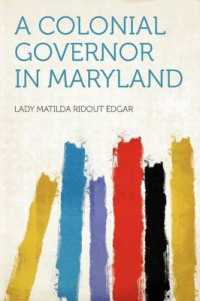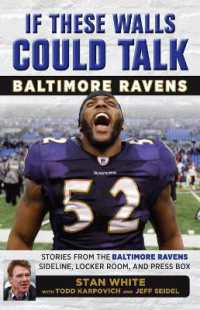- ホーム
- > 洋書
- > 英文書
- > History / World
Full Description
Studies in Upplandic Runography is a detailed treatment of the runic inscriptions from the province of Uppland, Sweden, where runic art reached a high point in A.D. 1200 and where runic inscriptions are most numerous. Most of the runic monuments discussed are from the eleventh century, an important period when Sweden was making the transition from paganism to Christianity.
The names of nearly fifty rune-carvers (runographers), professional and amateur, are known. However, many of the inscriptions were left unsigned. Claiborne Thompson examines the major problem of how an unsigned inscription is attributed to a known carver. Since each carver had a distinctive style which must be delineated, the book contains an exhaustive survey of the norms of Upplandic runography. In order to match the inscriptions with their carvers, Thompson analyzes the entire corpus of inscriptions from Uppland, their formation, the artistic designs they bear, the shapes of the runes on them, the orthography and language on them, and the manner in which they were carved.
Thompson then establishes a set of criteria for determining the authorship of a runic monument, stressing rune forms. All of the criteria are used in an extensive discussion of the carvings of Asmund Karasun, an interesting and influential carver from the first half of the eleventh century.
In addition, Thompson's review of research describes scholarly interest in the problems of runography beginning in the early seventeenth century. The book includes an introductory sketch of the cultural background of Uppland and relates the runic tradition to historical and cultural traditions in eleventh-century Sweden.
Contents
Acknowledgments
1. Introduction
2. Formulation
The Memorial Formula
The Prayer
The Addition
The Signature
3. Design
4. Rune Forms
5. Orthography and Language
Consonants
Semi-vowels
Vowels
Diphthongs
Cryptography
6. Technical Considerations
The Material
Cutting and Dressing the Stone
Carving
7. Runographers, Attributions, and the Five Criteria
8. Asmund Karasun
Signed Asmund Stones
Distinguishing Features of Asmund's Style
Possible Signed Asmund Stones
Signed Asmund Stones with Co-Runographers
Unsigned Runic Monuments with Asmundic Features (part 1)
Unsigned Runic Monuments with Asmundic Features (part 2)
Other Monuments Perhaps Connected to Asmund
Summary of Signed and Attributed Stones
Chronological Questions
The Asmund-Osmundus Question
9. Appendix: Previous Studies
The Seventeenth and Eighteenth Centuries
The Nineteenth Century
The Twentieth Century
Bibliography
Index
Index of Inscriptions








